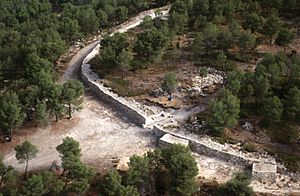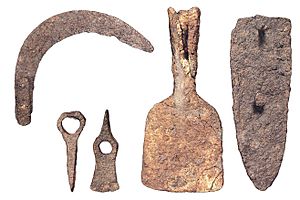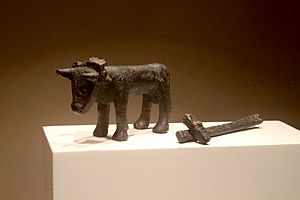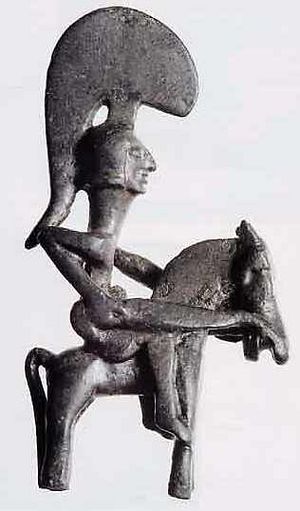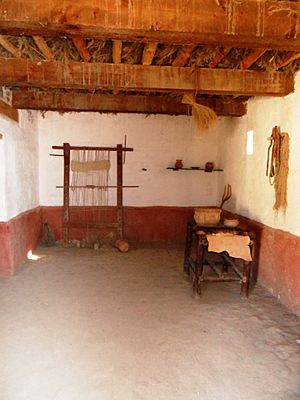La Bastida de les Alcusses facts for kids
La Bastida de les Alcusses is an ancient Iberian city from the 4th century BC. It is located near Mogente/Moixent in Valencia, Spain. This site is one of the most important Iberian archaeological discoveries in the Valencian Community. It is special because it was suddenly left empty and is very well preserved.
The city sits high up, 741 meters above sea level. It's about 200 meters above the valley floor, at the southwest end of the Serra Grossa mountains. The site is quite large, covering over 4 hectares. It stretches 650 meters long and 150 meters wide. Today, it's an archaeological park surrounded by pine trees and bushes, and you can get there by road.
Contents
Discovering the Ancient City
The site of La Bastida de les Alcusses was first mentioned in 1909 by Luis Tortosa. The first archaeological digs started in 1928. These were done by a new group called the Servicio de Investigación Prehistórica of the Valencian Community. They worked on the site four times between 1928 and 1931.
During these early digs, about 250 rooms were uncovered. Many important items were found, including the famous Guerrero de Mogente statue. Small lead plaques with ancient Iberian writing were also discovered, along with weapons and jewelry. Newspapers at the time even called the site a "new Pompeii" because of how well-preserved it was. More excavations have taken place in the 1990s and in recent years.
Strong Walls and Gates
The city was protected by strong walls, which were over 3 meters thick in the most vulnerable spots. There were four gates that allowed people to enter the city. Three of these gates were on the western side, and one was on the eastern side.
Two towers stuck out from the wall on the western side, where the main gate was located. All the gatehouses had benches inside. These might have been for guards or for checking goods coming into the city. The gates themselves were made of wood and strengthened with iron bands. The lower part of the gates and walls, made of stone, is still there today. The upper part, which was likely made of adobe bricks and had a walkway, is gone.
On the western side, there might have been an extra area outside the main walls. This area might have been less strongly fortified. It could have been a safe place for people from the surrounding area during attacks. Interestingly, the two smaller gates on the western side were blocked up while the city was still lived in. This was probably done to make the city even harder to attack.
City Layout and Homes
The buildings in La Bastida were built around a main street that ran from east to west through the middle of the city. Smaller streets branched off from this main street. Some open areas were left without buildings, possibly as public spaces. A shared storage building for grain was found in the center of the city.
The houses varied in size, from 20 to 150 square meters. They were built using the same method as the city walls: adobe bricks on top of a stone base. The walls would have been painted white and sometimes even decorated. The houses had only one floor, but their flat roofs were accessible. People might have used the roofs for different activities.
Experts believe there were about 90 to 120 houses in the city. This means between 450 and 840 people might have lived there. The most important part of each house was the hearth, or fireplace. This was the central meeting point for families. A storage room at the back of the house was used to keep food and tools. Other spaces were used for grinding grain and for special activities like working with metal, weaving, and other crafts.
Daily Life: Farming and Trading
Farming and raising animals were very important for daily life in La Bastida. The main crops were cereals like barley, wheat, and millet, which didn't need irrigation. They also grew legumes such as broad beans and peas. Fruits and nuts were also important, especially olives, grapes, almonds, and figs.
Farmers used wooden plows with iron tips, and many of these tips have been found in the city's houses. Other farming tools found include billhooks, sickles, hoes, and rakes. This collection of tools is one of the most complete examples of pre-Roman farming tools in Spain.
The most common animals raised were sheep and goats, along with some cows and pigs. These animals provided milk, wool, leather, and meat. They were also used for plowing fields and pulling carts. People also hunted wild animals like rabbits, hares, deer, mountain goats, and wild boar. Fish hooks found at the site show that the nearby Canyoles river was also a source of food.
Trade and business were also a big part of the city's economy. Weights and balances have been found, which were likely used for buying and selling goods. Small silver and bronze pieces, called ingots, were also found. The silver was made by a process called cupellation, which involves heating lead. This was done in some of the houses.
One of the lead plaques found has a list of names with different amounts next to them. Many of the names are crossed out. This plaque is thought to be a record of accounts or receipts. It is 180 by 40 millimeters and 1 millimeter thick. It was found rolled up under a grinding stone during the 1928 excavations.
Many objects found at the site show that La Bastida traded with places across the Mediterranean Sea. For example, amphoras (large jars) from the Strait of Gibraltar contained salted fish. Among the local pottery, plates and cups imported from Athens were found. Some of these imported items were even copied by local Iberian potters.
Society and Status
The people living in La Bastida had a society with different levels of status. A person's importance and wealth could be seen in their jewelry, the size of their house, and the imported goods they owned.
The Guerrero de Mogente, a small bronze statue, likely shows an important man. He is shown without clothes to highlight his heroic nature. He carries a special Iberian curved sword called a falcata and a small round shield (caetra). He also wears a helmet with a large feather. Offerings found at the main western gate, including a sword and shield, also show the importance of military gear. The fact that swords were found with plows might mean that important people also controlled good farming land. Important women might have been identified by their fine clothes and were linked to weaving tools.
The City's End
The settlement of La Bastida was only lived in for a short time, perhaps three or four generations. It was destroyed around 330 BC. The fact that two of the gates were blocked, signs of a fire, and many weapons and personal items found in the streets all suggest a quick and violent end to the city.
It's not clear exactly why La Bastida was attacked. It most likely happened during conflicts between different Iberian groups. We don't know if all the fighters were from the local area or if groups from further away were involved. The many cities in the area might have been fighting for control of important trade routes from the coast to the southern Meseta. They might also have been fighting for control of good farming land in the Canyoles valley.
Visiting La Bastida
You can visit the Museum of Mogente/Moixent and the site of La Bastida all year round. Entry to the site is free! The site is open from 10 AM to 2 PM and from 4 PM to 6 PM in winter. In summer, it's open from 4 PM to 8 PM. It is closed on Mondays.
The site offers a guide service, and there are also information panels if you want to explore on your own. Right outside the site, a full-size replica of an Iberian house has been built. It uses the same materials and building methods as the original houses. Also, many of the items found at La Bastida can be seen at the Valencian Museum of Prehistory. You can visit their website here.
See also
 In Spanish: Poblado íbero de la Bastida de les Alcusses para niños
In Spanish: Poblado íbero de la Bastida de les Alcusses para niños




